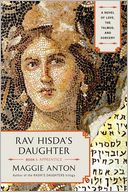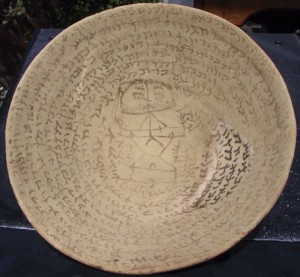We are pleased to welcome guest blogger, Maggie Anton, long time HUC patron, author, and lover of all things Talmud.
 When I began researching third-century Babylonia for my historical novel, Rav Hisda’s Daughter, I had never imagined that the subtitle would be “A Novel of Love, the Talmud and Sorcery.” But I soon learned that magic, whose etymology comes from Magi, the scholar-priests of Zoroastrian Babylonia, was pervasive throughout Persia. My initial glimpse of this world came when I discovered a corpus of research on Babylonian Incantation Bowls.
When I began researching third-century Babylonia for my historical novel, Rav Hisda’s Daughter, I had never imagined that the subtitle would be “A Novel of Love, the Talmud and Sorcery.” But I soon learned that magic, whose etymology comes from Magi, the scholar-priests of Zoroastrian Babylonia, was pervasive throughout Persia. My initial glimpse of this world came when I discovered a corpus of research on Babylonian Incantation Bowls.
These were ordinary pottery with inscriptions inside whose purpose was to protect the people under whose home the vessels were buried. Thousands of these bowls had been unearthed in what is now Iraq and dated to the 4th-6th century. My initial interest in the incantations, written in the same Aramaic language as the Talmud, was purely as a source of authentic women’s names. But upon careful reading, I saw that they must have been produced by educated Jews.
Most were for benevolent purposes – healing the sick, protecting children and pregnant women from harm, guarding against demons and the Evil Eye. The spells often contained biblical verses and drawings of bound demons. One even quoted Talmud. The bowl pictured here, one of two I own, includes the verse from Zechariah 3:2, “May the LORD rebuke you, O Satan.”
Archeologists have also found amulets with similar, albeit shorter, incantations written by Jews throughout the Persian and Roman empires. They discovered Hebrew magic instruction manuals that list an astonishing variety of spells, some benevolent and some not. My favorite was one for winning at chariot races.
Meanwhile, I learned that the Talmud contains discussions of spells, amulets, demons, the Evil Eye, and other occult subjects. Some rabbis, including Rav Hisda, performed acts of magic themselves, but our Sages agreed that sorcery was predominantly the province of women. Though the Bible says, “You shall not allow a sorceress to live,” these women apparently practiced freely. They were respected professionals, not scary hags with pointy hats as in Wizard of Oz. The Talmud even tells of a rabbi who consulted the ‘head sorceress’ to learn a special protective spell.
When I read that Rav Hisda’s daughter demonstrated ways of protecting her husband Rava, a rabbi well versed in magic himself, from demons, I realized that my heroine was an enchantress! Indeed, sorceresses who inscribed incantation bowls were probably members of rabbinic families too, for what other Jewish women would be learned enough to create them?
In the end, the difference between Rav Hisda’s Daughter and novels like Harry Potter is that Harry’s magic is product of Rowling’s imagination, while I use actual, historical spells and procedures as found in incantation bowls, amulets, and the Talmud.
Maggie Anton
p.s. from Sheryl. If you are interesting in learning more, check our catalog for books on magic, incantations, amulets, or witchcraft. Also look for Maggie Anton’s earlier books on Rashi’s daughters.


Thank you for posting Maggie’s guest post. We had a Jewish Women’s community read, in Myrtle Beach. We were reading Dovekeepers by Alice Hoffman. What came off of that is our next read. Not, knowing about Maggie’s new book. We decided we wanted to learn about Jewish Women, Healers, Sorcery, and Amulets. We found the subject, but not the book. Then by chance, I found out about Rabbi Hisda’s Daughter. I was fascinated. Because growing up, always thought Judiasm did’t believe in magic, and did not realize we did have some knowledge of it. Wondered if it was legal to do it or not. I will just have to find out, when we have our discussion next summer.